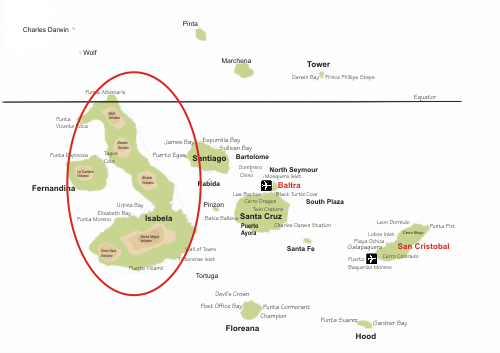| VISITOR
SITE |
WHAT TO
SEE |
Tagus Cove
a favorite site of early pirates and whalers, who left the names of their ships painted on
the high cliffs which enclose the protected bay. The tour along the cliffs gives the
visitor a good chance to see the illusive Galapagos penguin. |
Cinder volcanoes
penguins
flightless cormorants
noddy terns
crater with salt lake |
marine iguanas
pelicans
Audubon Shearwater
blue-footed boobies |
|
Urbina Bay
located on the western coast at the foot of Alcedo Volcano, this area was uplifted from
the sea in 1954. The site is relatively flat, distinguished by corals and other marine
formations which were lifted out of the sea by the uplift. |
flightless cormorants
brown pelicans |
large marine iguanas
rays
marine turtles |
|
Elizabeth Bay
on the western shore is an extremely interesting area for observing marine life in many
different forms.After motoring past a few small islands, it is possible to enter a narrow
passage lines with mangroves and emerge into an enclosed cove where marine turtles, rays
and flight cormorants may be seen in the sheltered waters. |
area of giant red mangroves
occasional penguin
sea turtles
pelicans |
sea lions
lava herons
rays
flightless cormorants |
|
Wall of Tears
A
penal colony from 1945 to 1959. Wall of Tears was erected by convicts, stone by stone.
This historical site, towering at 65 feet high, took the lives of thousands during its
construction. |
wall
of Tears
dry lowland vegetation
wetlands
mangroves |
flamingos
finches
pelicans
booby |
|
Tintoreras Islet
Located a short distance south of Puerto Villamil, Tintoreras Islet has a small bay of
calm turquoise waters where you can appreciate sea lions, sea turtles, marine iguanas,
rays etc. The bay is connected to a crevice of crystal clear water where you can see how
reef sharks swim along with other fish and sea lions. Throughout the trail you can see
marine iguanas on the rocks or under the mangroves. This is one of the few places where
the iguanas breed successfully because of the absence of non-native animals that could
kill their young. |
lava
formations
marine iguanas
sea lions |
sea
turtles
penguins
white tipped reef sharks |
|
Puerto Vilamil
a small port town of approximately 2000 inhabitants located on the southeastern edge of
Isabela Island. On the southwestern edge of town a boardwalk was created by the park which
leads through mangrove environments passing along saltwater lagoons filled with flamingo,
common stilts, whimbrels, Bahama pintails and gaiollinules that come here to sweep the mud
in search of brine. At the end of the walkway is the Tortoise Breeding Center which was
built in order to help preserve the many species of Isabela Tortoises. |
Tortoise
Breeding Station
white sand beach
wetlands
marine iguanas
flamingos |
common
stilts
whimbrels
stilts
lava gulls
sanderlings |
|
Punta Moreno
located on the southwestern side of Isabela Island between the volcanos of Sierra Negra
and Cerro Azul. The trail runs along a lava flow Pahohoe (solidified lava in the form of
corrugated or an accordion) into a complex of coastal lagoons that are a magnet for
wildlife. Panoramic view of three volcanoes, the most active of the Galapagos that are
Sierra Negra, Cerro Azul of Isabela Island and La Cumbre of Fernandina Island. |
frigate birds
flamingos
pelicans
Darwin finches
penguins |
blue footed boobies
mockingbirds
flightless cormorants
Galapagos doves |
|
Punta Vicente Roca
located on Isabela Island, the largest island of the Galapagos. The island is shaped like
a sea horse and Punta Vicente Roca is at the “mouth” of the sea horse’s
head. Small promontory with two coves on either side of the remnants of an ancient
volcano. The bay is well shielded from the ocean’s open swells. Popular for
scuba-diving with abundant ocean life making it one of the archipelago’s sought after
dive spots. Masked and blue-footed boobies and flightless cormorants can be seen on
the shoreline. |
volcanoes
bird watching
sea lions |
|
Punta Albemarle
located on the north of Isabela Island, Punta Albemarle was the old name of the island.
The site comprises two areas. Firstly, a mangrove area between Pahohoe lava flows forming
creeks and channels ideal for traveling by panga. The second point of access is the former
radar base left by Americans during World War II near the beach. The marine iguanas of
Punta Albemarle and West of Isabela are the largest in the archipelago. Ideal for a panga
ride where you can see flightless cormorants, marine iguanas, sea birds and many marine
species. |
WW II American radar station
marine iguanas
flightless cormorant |




